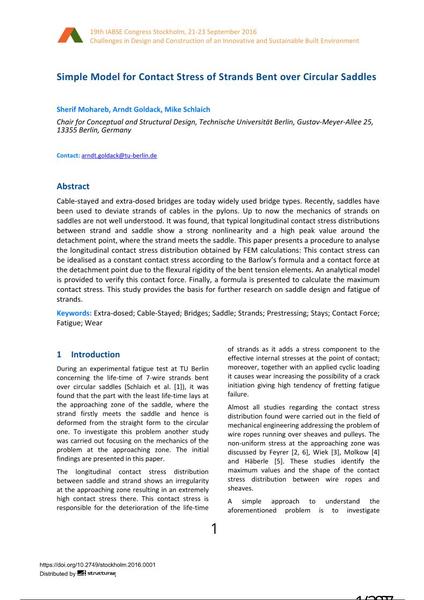Simple Model for Contact Stress of Strands Bent over Circular Saddles

|
|
|||||||||||
Bibliographic Details
| Author(s): |
Sherif Mohareb
(Chair for Conceptual and Structural Design, Technische Universität Berlin, Gustav-Meyer-Allee 25, 13355 Berlin, Germany)
Arndt Goldack Mike Schlaich (Chair for Conceptual and Structural Design, Technische Universität Berlin, Gustav-Meyer-Allee 25, 13355 Berlin, Germany) |
||||
|---|---|---|---|---|---|
| Medium: | conference paper | ||||
| Language(s): | English | ||||
| Conference: | IABSE Congress: Challenges in Design and Construction of an Innovative and Sustainable Built Environment, Stockholm, Sweden, 21-23 September 2016 | ||||
| Published in: | IABSE Congress Stockholm, 2016 | ||||
|
|||||
| Page(s): | 1-8 | ||||
| Total no. of pages: | 8 | ||||
| Year: | 2016 | ||||
| DOI: | 10.2749/stockholm.2016.0001 | ||||
| Abstract: |
Cable-stayed and extra-dosed bridges are today widely used bridge types. Recently, saddles have been used to deviate strands of cables in the pylons. Up to now the mechanics of strands on saddles are not well understood. It was found, that typical longitudinal contact stress distributions between strand and saddle show a strong nonlinearity and a high peak value around the detachment point, where the strand meets the saddle. This paper presents a procedure to analyse the longitudinal contact stress distribution obtained by FEM calculations: This contact stress can be idealised as a constant contact stress according to the Barlow’s formula and a contact force at the detachment point due to the flexural rigidity of the bent tension elements. An analytical model is provided to verify this contact force. Finally, a formula is presented to calculate the maximum contact stress. This study provides the basis for further research on saddle design and fatigue of strands. |
||||
| Keywords: |
bridges fatigue wear prestressing strands cable-stayed Stays saddle contact force extra-dosed
|
||||


